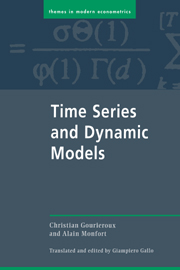Book contents
Preface
Published online by Cambridge University Press: 30 January 2010
Summary
The analysis of the evolution of one or more time varying phenomena has long been the domain of interest of experts in various fields. Probability theorists have built an impressive mathematical construction, the theory of stochastic processes, which allows one to study in great detail the properties of a set of random variables indexed by time. Statistical theorists have suggested a number of approaches to the problems of estimation, of hypothesis testing, of forecasting, of filtering, of smoothing for the stochastic processes. Empirical analysts in many fields (physics, engineering, economics…) have developed suitable techniques to solve their own problems, thus creating a wide array of analytical tools which are not always rigorously linked to the theoretical literature.
Confronted with this huge variety of suggestions in time series analysis, the interested students and researchers find themselves somewhat at a loss. The goal of this book is to help them in their training. In order for this help to be effective it was important to avoid too much abstraction or alternatively a mere support to practitioners without any theoretical content. We have tried our best to navigate between these two courses, granting ourselves some freedom from mathematical formalism when it became too cumbersome, but also highlighting the weak theoretical support of certain practices.
Mostly, we have tried to present a variety of aspects of time-series analysis in a synthetic manner: statistical problems, such as seasonal adjustment and forecasting; econometric problems, such as causality, exogeneity, cointegration, and expectations; and some engineering problems, such as Kalman filtering and smoothing. In deciding on the boundaries of the exposition, we were obviously forced to cut out many aspects of time-series analysis, mainly those related to nonlinearities.
- Type
- Chapter
- Information
- Time Series and Dynamic Models , pp. xiii - xviPublisher: Cambridge University PressPrint publication year: 1996
- 2
- Cited by

